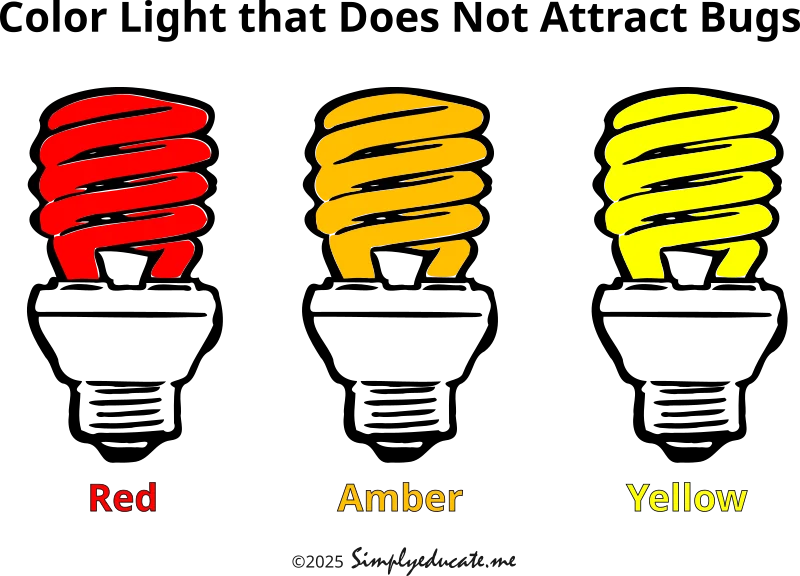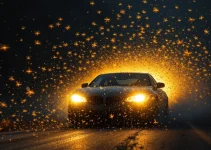
Table of Contents
Introduction
Have you ever noticed how bugs seem to swarm around your outdoor lights during warm evenings? Many of us enjoy spending time outside, but the glow of typical outdoor lighting often attracts unwanted insects. Identifying which colors of light are less appealing to bugs can make your outdoor experiences more enjoyable.
In this article, we answer the essential question: “What color light does not attract bugs?”
We’ll explore the science behind bug attraction to light, identify which colors are most appealing to insects, and highlight practical solutions for reducing bug encounters.
The Science Behind Light and Bug Attraction
Bugs are naturally drawn to light due to their navigation and survival instincts. Most insects use natural light sources, such as the moon, to orient themselves. Artificial lights, however, disrupt their navigation systems.
The spectrum of visible light ranges from violet and blue to red. Bugs are highly sensitive to certain wavelengths, especially those in the ultraviolet (UV) and blue light range. These wavelengths are similar to natural light sources insects use for guidance, making them more attractive.
Insects perceive light differently than humans do. Many can see UV light, which is invisible to the human eye, but find colors like yellow, amber, and red less stimulating. This difference in perception is the key to understanding which lights repel bugs.
What Color Light Attract Bugs?
Certain colors are notorious for drawing insects. I enumerate them below:
- White Light: Emits a broad spectrum including UV and blue wavelengths, which are highly attractive to most insects.
- Blue Light: Shorter wavelengths that mimic the sky and moonlight, appealing to bug navigation.
- Ultraviolet (UV) Light: Extremely attractive to insects because it resembles sunlight and floral reflections.
Using these lights outdoors often leads to swarms of mosquitoes, moths, and other flying insects, which can be a nuisance.
Related Post: 18 Kinds of Tiny Bugs Attracted to Light at Night
What Color Light Does Not Attract Bugs?
So, which colors are safer choices for bug-free illumination? What color light does not attract bugs?
The answer lies in the wavelengths less visible or stimulating to insects.
- Red Light: Red light has longer wavelengths and is almost invisible to most insects.
- Amber Light: Amber-colored lights reduce the number of insects drawn to your space while maintaining adequate visibility.
- Yellow Light: Bugs are less sensitive to yellow wavelengths, making yellow bulbs effective at minimizing insect attraction.
Scientific studies confirm that these colors reduce bug activity because insects cannot perceive them as easily, making them ideal for outdoor lighting.
So when you want to buy bulbs or compact fluorescent lamps (CFL) for use as lighting at night, or go on a camp, just remember the word RAY: R for Red, A for Amber, and Y for yellow.
Among these three colors, amber light provides a good balance of visibility, reduced glare, and minimized insect attraction. These features make amber light very useful for outdoor lighting at night.
Although yellow light is less attractive to insects than white light, it can sometimes be too dim for some outdoor activities. Also, while red light is least attractive to insects and preserves night vision by maintaining eye adjustment to darkness, it’s generally not attractive for illuminating outdoor areas due to lower visibility.
Overall, it may be a matter of personal preference and purpose. Surely, these three color lights do not attract bugs at night as conventional white light bulbs or CFLs do.
Guide on Which Color Light to Install at Home
To achieve a certain ambiance favorable to your mental health and daily routine, you may vary the color light that does not attract bugs in different parts of your home.
Here is a guide on where each of these three color lights that does not attract bugs at night might be most effectively used:
Red Light
Bedrooms: Red light is ideal for bedrooms, especially in nightstand lamps, as it doesn’t disrupt sleep cycles. Red light can help create a calming atmosphere conducive to rest.
Meditation or Relaxation Spaces: The calming nature of red light makes it suitable for spaces dedicated to meditation or relaxation, helping to reduce stress.
Amber Light
Entryways and Porches: Amber light is excellent for entryways and porches as it provides good visibility without attracting too many insects.
Living Rooms: The warm tone of amber lighting creates a cozy atmosphere, making it suitable for living rooms where relaxation is key.
Outdoor Spaces: Amber lighting is beneficial for patios or gardens, reducing light pollution and its impact on wildlife.
Yellow Light
Kitchens and Dining Areas: Yellow light can create a warm and inviting environment in kitchens and dining areas, promoting a sense of comfort and friendliness.
Hallways: Yellow lighting is well-suited for hallways, providing a soft yet effective illumination that is easy on the eyes while passing through.
Each of these lighting types can be effectively used in combination with others to create the desired ambiance and functionality in your home.
Practical Applications and Benefits
Using bug-repellent lighting has several advantages:
- Outdoor Activities: Camping, backyard gatherings, and evening parties become more comfortable without swarms of insects.
- Home Lighting: Front porches, patios, and decks can be illuminated without attracting large numbers of bugs.
- Environmental and Health Benefits: Reduced insect attraction lowers the need for chemical repellents, promoting a healthier outdoor environment. And it’s good for wild life, too.
Choosing the right light color can significantly enhance your outdoor experience while being environmentally friendly.
Conclusion
Discerning what color light does not attract bugs can make a noticeable difference in your outdoor comfort. Red, amber, and yellow lights are effective options for reducing insect encounters, while white, blue, and UV lights should be avoided especially if you are living near the forest.
By applying this knowledge, you can enjoy evenings outside, protect yourself from bug bites, and even contribute to a safer, chemical-free environment.
References
Colgan, D. (2021). Study reveals which outdoor lighting minimizes harm to insects. UCLA. Retrieved September 28, 2025, from https://newsroom.ucla.edu/releases/outdoor-lighting-protecting-insects-amazon-basin
Deichmann, J. L., Ampudia Gatty, C., Andía Navarro, J. M., Alonso, A., Linares‐Palomino, R., & Longcore, T. (2021). Reducing the blue spectrum of artificial light at night minimises insect attraction in a tropical lowland forest. Insect Conservation and Diversity, 14(2), 247-259.
Justice, M. J., & Justice, T. C. (2021). Insect attraction to the six major types of traditional-style, residential light bulbs and implications for insect survival and light pollution. bioRxiv, 2021-05.
Owens, A. C., Pocock, M. J., & Seymoure, B. M. (2024). Current evidence in support of insect-friendly lighting practices. Current Opinion in Insect Science, 66, 101276.
Pan, H., Liang, G., & Lu, Y. (2021). Response of different insect groups to various wavelengths of light under field conditions. Insects, 12(5), 427.
Additional Resources
FAQ: What Color Light Does Not Attract Bugs?
Q1: Do bugs dislike all red lights?
Most insects cannot perceive red light, making it less attractive. However, some species may still detect it in low-intensity settings.
Q2: Can yellow lights really prevent mosquitoes?
Yes. Yellow lights emit wavelengths less visible to insects, reducing their attraction and minimizing mosquito presence.
Q3: Are bug-repellent lights safe for humans?
Absolutely. Yellow, amber, and red lights are safe for humans and provide adequate illumination for outdoor activities.
Q4: Should I avoid blue and white lights outdoors?
If you want to reduce bugs, it’s best to limit blue, white, and UV lights, as they attract most flying insects.
Q5: Can these lights be used for gardens and patios?
Yes. Bug-repellent lighting works well for outdoor spaces, allowing you to enjoy gardens and patios without swarms of insects.


